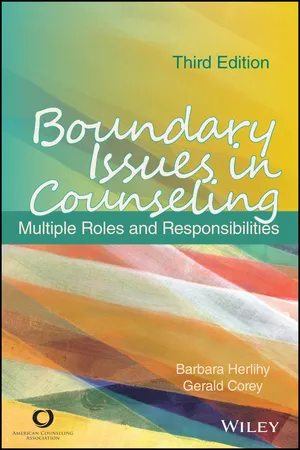
Boundary Issues in Counseling
Multiple Roles and Responsibilities
- English
- ePUB (mobile friendly)
- Available on iOS & Android
About this book
Fully revised in accordance with the 2014 ACA Code of Ethics and the current ethical codes of other mental health organizations, Boundary Issues in Counseling reflects the helping profession's most up-to-date thinking on this topic and offers a wide range of opinions and perspectives. Ethics experts Barbara Herlihy and Gerald Corey, along with 40 guest contributors, share their thoughts on the ethical issues surrounding sexual dual relationships; multiculturalism and social justice; counselor education, supervision, and consultation; group counseling; couples and family counseling; and school counseling. In addition, coverage extends to specialty areas, such as disaster mental health, private practice, addictions and rehabilitation counseling, rural practice, counseling in the military and forensic counseling.
This highly regarded book is essential reading for counselors struggling to find a clear personal position on the myriad issues that can arise with multiple relationships. It is also an ideal supplemental text for courses in ethics and professional issues, as well as for practicum and internship seminars to train the next generation of counselors.
*Requests for digital versions from ACA can be found on wiley.com. *To request print copies, please visit the ACA website.
*Reproduction requests for material from books published by ACA should be directed [email protected]
Frequently asked questions
- Essential is ideal for learners and professionals who enjoy exploring a wide range of subjects. Access the Essential Library with 800,000+ trusted titles and best-sellers across business, personal growth, and the humanities. Includes unlimited reading time and Standard Read Aloud voice.
- Complete: Perfect for advanced learners and researchers needing full, unrestricted access. Unlock 1.4M+ books across hundreds of subjects, including academic and specialized titles. The Complete Plan also includes advanced features like Premium Read Aloud and Research Assistant.
Please note we cannot support devices running on iOS 13 and Android 7 or earlier. Learn more about using the app.
Information
Chapter 1
Boundary Issues in Perspective
- What guidance do our codes of ethics offer about dual or multiple nonprofessional relationships?
- What makes dual or multiple relationships problematic?
- What factors create the potential for harm?
- What are the risks (and benefits) inherent in dual or multiple relationships, for all parties involved?
- What important but subtle distinctions should be considered?
- What safeguards can be built in to minimize risks?
Ethical Standards
Sexual and/or Romantic Relationships Prohibited
Sexual and/or romantic counselor–client interactions or relationships with current clients, their romantic partners, or their family members are prohibited. This prohibition applies to both in-person and electronic interactions or relationships. (Standard A.5.a.)
Previous Relationships
Counselors consider the risks and benefits of accepting as clients those with whom they have had a previous relationship. These potential clients may include individuals with whom the counselor has had a casual, distant, or past relationship. Examples include mutual or past membership in a professional association, organization, or community. When counselors accept these clients, they take appropriate professional precautions such as informed consent, consultation, supervision, and documentation to ensure that judgment is not impaired and no exploitation occurs. (Standard A.6.a.)
Extending Counseling Boundaries
Counselors consider the risks and benefits of extending current counseling relationships beyond conventional parameters. Examples include attending a client’s formal ceremony (e.g., a wedding/commitment ceremony or graduation), purchasing a service or product provided by a client (excepting unrestricted bartering), and visiting a client’s ill family member in the hospital. In extending these boundaries, counselors take appropriate professional precautions such as informed consent, consultation, supervision, and documentation to ensure that judgment is not impaired and no harm occurs. (Standard A.6.b.)
Documenting Boundary Extensions
If co...
Table of contents
- Cover
- Title Page
- Copyright
- Dedication
- Preface
- About the Authors
- Guest Contributors
- Chapter 1: Boundary Issues in Perspective
- Chapter 2: Sexual Dual Relationships
- Chapter 3: The Client’s Perspective
- Chapter 4: Multicultural and Social Justice Perspectives on Boundaries
- Chapter 5: Issues in Counselor Education
- Chapter 6: Issues in Supervision and Consultation
- Chapter 7: Education and Training of Group Counselors
- Chapter 8: Group Counseling and Couples and Family Counseling
- Chapter 9: Boundary Issues in School Counseling
- Chapter 10: Focus on Specialty Areas: Disaster Mental Health, Private Practice, Addictions Counseling, and Rehabilitation Counseling
- Chapter 11: Focus on Specialty Areas: Rural Practice, Counseling in the Military, Counseling Clients With End-of-Life Concerns, In-Home Service Provision, Forensic Psychology and Counseling
- Chapter 12: Key Themes, Questions, and Decision Making
- References
- Index
- Technical Support
- End User License Agreement